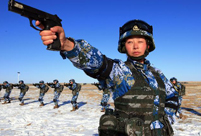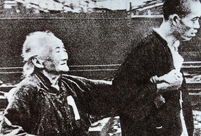 Chinese artists from Flight MH370 and their art
Chinese artists from Flight MH370 and their art
 Top 30 entrepreneurs under 30 in China
Top 30 entrepreneurs under 30 in China
 800-year-old ancient village in Shanxi
800-year-old ancient village in Shanxi
 World's top 10 most prestigious institutions
World's top 10 most prestigious institutions
 Chinese airborne troops conduct low altitude flight training
Chinese airborne troops conduct low altitude flight training
 Beautiful fisherwomen in SE China
Beautiful fisherwomen in SE China
 1,500-year-old coffin excavated from grassland in N China
1,500-year-old coffin excavated from grassland in N China
 See what Google glass captures at 'two sessions'
See what Google glass captures at 'two sessions'
 In pictures: beautiful women in different ages
In pictures: beautiful women in different ages
In this sense, the CPC should better be viewed as a state party or, in a hypothetical American context, a merge of the Republican and Democratic parties in which competition of ideas and competence is the norm and consensus and can-do spirit is prized.
"China is not an East Germany writ large awaiting a color revolution, as perceived by many in the West. Rather, it is a civilizational state, an amalgam of the world's longest continuous civilization with a huge modern state, which is also a product of hundreds of states amalgamated into one over its long history."China is not an East Germany writ large awaiting a color revolution, as perceived by many in the West. Rather, it is a civilizational state, an amalgam of the world's longest continuous civilization with a huge modern state, which is also a product of hundreds of states amalgamated into one over its long history. It is analogous, perhaps, to the Roman Empire, but continuous to this day, with all its diverse regional and cultural differences joined to a modern economy and centralized government, with its people speaking the same one language like Latin.
This kind of state may indeed become ungovernable and break up if it ventures into the Western adversarial political model just as the Soviet Union did -- a lesson that Chinese leaders seem to have taken to heart. China's meritocratic system, in line with its own tradition and various adaptations such as widely practiced "selection plus election" governance system, seems working reasonably well for China. Imperfect as it is, this system can compete with other political models in the world.
Second, neo-democratic centralism. China's success is inseparable from its much reformed decision-making process, which can be described as neo-democratic centralism or a modern form of democratic centralism. The old Soviet-style decision-making process was indeed more about centralism than democracy, but China has improved on it and institutionalized a procedural accountability for its democratic centralism. Under such a system, a typical major decision like the nation's five-year plan for development takes well over a year of extensive and interactive consultations at various levels of the Chinese state and the society, with several cycles of "from the people to the people, and to the people from the people".
This decision-making process receives inputs from thousands of think tanks, government agencies, universities, prominent scholars and professionals, including not infrequently heated debates in the social media and on the micro-blogging Weibo.
The recently adopted Third Plenum's decision on deepening reforms is a good example in this regard. Its drafting group, chaired by President Xi Jinping himself, solicited opinions from well over 100 institutions across the country and received 2500 suggestions over a period of half a year. About 50 percent of these suggestions were accepted. And during the process, all the seven top leaders went to different regions of China to make investigations in preparation for the deliberations on the decision.
As a result, the final decision reflects the broad consensus of Chinese society on many issues such as public health reform, adjustment of the one child policy, deferred retirement age, banking sector reform, education reform and the end of the "reform through labor" system. Many decisions are made based on the results of pilot projects.
With a higher degree of legitimacy in the decision-making process, there is usually no need to "sell" the state's decisions, as the United States does, to the public. Once decisions are made in Beijing after such a process, they are usually ready for "study and execution" or to be further tested in various pilot projects.


 Chaihe village, pure and peaceful fairyland in snow
Chaihe village, pure and peaceful fairyland in snow Belgians warmly welcome arrival of China's giant pandas
Belgians warmly welcome arrival of China's giant pandas Female marines receive tactical training in NW China
Female marines receive tactical training in NW China Blood memory: Nanjing Massacre in 1937
Blood memory: Nanjing Massacre in 1937 Top 10 pure beauties in showbiz
Top 10 pure beauties in showbiz British WWII veteran: I can't forgive Japan
British WWII veteran: I can't forgive Japan Tongban's dream of prosperity
Tongban's dream of prosperity Chinese frigate Yancheng holds drills in Mediterranean Sea
Chinese frigate Yancheng holds drills in Mediterranean Sea A visit to comfort woman's home in South Korea
A visit to comfort woman's home in South Korea Fairyland? Qingdao in sea of clouds
Fairyland? Qingdao in sea of clouds Top 10 most handsome faces in Asia in 2013
Top 10 most handsome faces in Asia in 2013 Female celebs with beautiful long legs
Female celebs with beautiful long legs Cat 'guardians' in Forbidden City
Cat 'guardians' in Forbidden City Large numbers of ancient coins excavated in Inner Mongolia
Large numbers of ancient coins excavated in Inner Mongolia Leisurely life beneath Zhonggulou, where time travels slower
Leisurely life beneath Zhonggulou, where time travels slowerDay|Week|Month